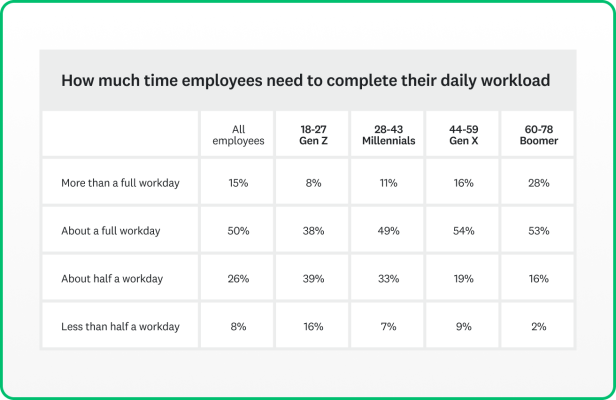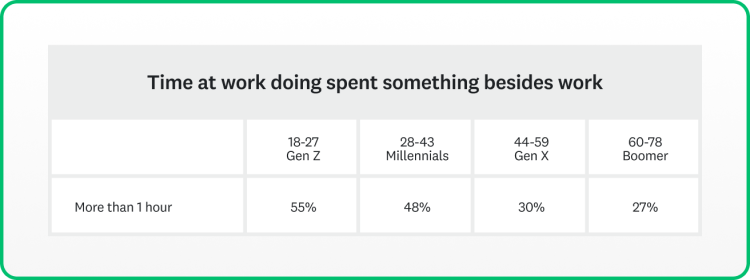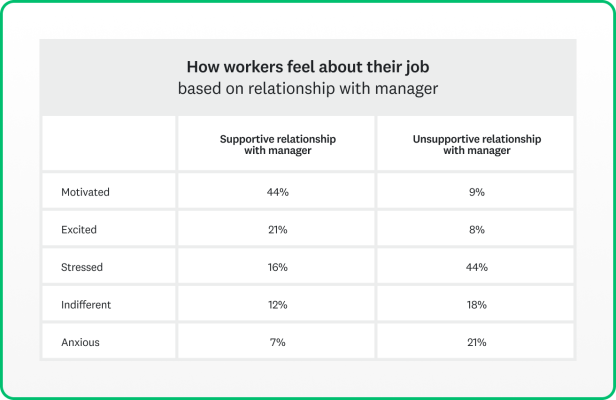Employees can be hesitant to provide honest feedback, but it turns out that you can get it—if you just ask.
It was with that in mind that we launched a project to learn more about the workplace. We asked people—during their daily commutes, while they were waiting in line—what they were really feeling about their jobs, their bosses, their colleagues, and the environment they called the workplace.
Here’s what made this study a little different. Instead of targeting specific people with an online survey, we posted ads with QR codes in seven major cities around the country; from Seattle to Miami to Chicago, and NYC. The ads asked questions in a way that we thought would encourage honest answers on a range of topics—returning to the office, relationships with co-workers, what makes work fun, and some juicy questions about workday behaviors that led to some interesting confessions.
And, we got answers. US workers are only too happy to provide honest feedback about what they like, what they could do without, and how to make work a better place for all of us.
That was our intention all along—to reveal the kind of insights that employers could act on to bring about a greater sense of wellbeing in the workplace. Because right now, the workplace is where life is happening for most of us.
Our study includes results from four surveys conducted out-of-home as well as additional feedback collected through online panels. We got responses from 4,296 people in total representing workers all over the country. Here’s what we learned.
1. Why workers stick around: insights about employee retention
Work-life balance for the win
Bonuses, raises, and promotions are the obvious reasons why workers stay at their jobs. However, not all workers rank money as the most important thing.
In our studies, work-life balance tops the list of things employees believe is most important—28% of all employees ranked it as the top issue compared to 27% who rank compensation as most important. Job security is a close follow; ranked as “most important” by 18% of employees, while 14% rank career growth opportunities and 12% company culture.
For Gen Z, work-life balance is the clear winner. Almost a third (32%) of Gen Z workers say work-life balance is most important, followed by career growth ( 22%); compensation (20%) comes in a distant third. Gen Z is also the least likely age group to view company culture (8%) as the most important aspect of their job.
Our research also found that remote work has made its mark on workers. When asked what they would do if required to return to the office, only half of workers (51%) say they would accept the mandate and make the most of it. Further, almost four in ten employees (38%) would consider looking for another job that offers remote work.
For HR teams hoping to hang on to top talent, that’s a pretty significant number of workers who would be planning an exit strategy if forced to return to the office. And, our research isn’t just hypothetical. Over half (51%) of workers who have recently been called back into the office said they are likely to look for another job, while another third (32%) said they will find reasons not to go back into the office.
Bad bosses are a hazard
It’s remarkable how much power a bad (or good) manager can have over employee retention. In fact, no matter what an HR team does, a bad manager can be the difference between why an employee stays or leaves your company.
44% of employees with supportive bosses report they are “motivated” about their jobs, compared to only 9% of those with an unsupportive boss
In our study, nearly one in four (24%) of workers report they would leave a job due to a bad manager, second only to employees leaving a job due to unethical business practices.
Surprisingly, only 17% of workers said they would leave their current job for more money, and 10% said they would leave for better benefits. Clearly, investing in developing strong management skills and recruiting experienced leaders would be a worthwhile way to stem employee attrition.
2. Employee productivity and performance drivers
Return to work reveals efficiencies—and distractions
As companies like Amazon and Salesforce make waves for ordering employees back to in-person work, productivity is top of mind for any employer who has a dispersed workforce.
In our study, employees weighed in. Half of workers (49%) say they prefer working from home, compared to 34% who want to work in-person.
Further, almost half of workers (46%) say they’re more productive working remotely, compared to 29% who report they are more productive in an office. These numbers are even higher for workers who returned to in-person work within the last 12 months—60% of workers recently called back report higher productivity when remote.
How many hours does it take to actually do the job?
Employee productivity is a big topic for a lot of reasons. First, remote and in-office workers have pointed out big distinctions in the benefits and inefficiencies of both workplaces. Second, a multi-generation workforce has uncovered some real differences in employee productivity based on age.
In our study, almost two-thirds of employees (65%) say they need a full work day or more to do their jobs. Just over one-third of workers (35%) say they can complete all their daily tasks in half a workday or less.

Gen Z is the most likely to report they can do more in less time, with 54% saying they need half a day or less to complete their jobs, compared to 40% of Millennials, 28% of Gen Xers, and 18% of Boomers.
However, the majority of the other generations say they need the full work day—or more—with 60% of Millennials, 70% of Gen Xers, and 81% of Boomers saying 8 hours or more is needed to complete their daily tasks.
As far as work from home vs. in-office; overall, 46% of employees believe they are more productive working from home, compared to 29% who think they are more productive in the office, and 23% who say it makes no difference.
Confessions of in-office and remote workers
While remote workers have been thrown some shade for their video-off actions, the fact is the workplace offers just as many distractions as a home office. In our studies, a large majority of workers (82%) report spending at least some time on activities unrelated to work during their shifts, such as browsing social media or chatting with coworkers.
In addition, four in ten (39%) workers spend more than one hour each day on non-work activities.

What drives employees nuts about coming into the office? It’s the little things—the extra time spent on getting to the office, for example. Four in ten (39%) workers dread the commute and (14%) say it's waking up early.
Some feedback points to the distractions that come with in-office work: 14% of employees struggle with unnecessary meetings that come from in office work, and 9% say it's the small talk with coworkers that is their least favorite part.
3. What drives good (and bad) employee engagement
Relationships with co-workers matter
What’s the secret sauce that keeps employees engaged? The answer might be simpler than you’d think—it’s at-work friendships.
Based on our research, half of all workers (51%) have a close friend at work, and those who do are happier and more motivated to do the job.
Workers with close friendships are more likely to be motivated in their job (44% vs. 34%) compared to those without a close relationship at work. They are also more likely to feel ‘very comfortable’ being themselves at work (36% vs. 30%).
Important relationships extend beyond co-workers—again, we’ve found that positive manager-employee relationships are vital. Almost nine out of ten (86%) of workers say they have a supportive manager—and those workers are much less likely to feel stressed or anxious at work.
In fact, the differences in employee wellbeing are directly impacted by the relationship a worker has with their manager. Workers who are supported are 5X more motivated (44% vs. 9%), less stressed (16% vs. 44%), and more excited (21% vs 8%) by work than workers who feel unsupported by their manager.

The value of age diversity
The multi-generation workforce has added some interesting layers for HR—it requires a wider variety of benefits, a diverse set of work styles, and a broad range of experiences. But our research shows that the advantages may outweigh the extra burden that HR teams are experiencing by having to meet a diverse set of employee needs.
A third (32%) of employees say they appreciate learning things from colleagues of different age groups that they couldn’t from same-aged peers; plus over a quarter (28%) believe that age diversity improves the workplace environment.
Every age group finds value in the diversity. Gen Z (36%) and Millennial (38%) workers value learning from older peers, while Gen X (31%) and Boomer (33%) workers believe that age diversity improves the workplace.
Younger workers seek wellbeing support from employers
Every generation seems to introduce a new requirement for HR teams. Millennials broke new ground in securing fertility and mental health benefits as well as more flexible offerings for family leave, which have become foundational offerings for many companies.
The fact is, all employees are interested in a more healthy and adaptive workplace, and are increasingly looking to employers to provide more support.
Six out of ten (61%) workers say their employer is proactive in promoting employee well-being, while less than a quarter ( 24%) say their employer is reactive. Only 13% of employees report that their workplace has no wellbeing policies in place.
Gen Z workers, in particular, feel less supported in this area, with only half (51%) saying their employer is proactive, compared to 60% of Millennial and 64% of Gen X workers.
There’s more to learn about today’s workplace and what employees really want. Check out our recent guide on Bridging the HR gap, and our recent study on workplace trends.
Methodology:
This SurveyMonkey research of a total of 3,908 adults 18+ spanned four separate studies conducted from October 15, 2024 to October 31, 2024. Responses were sourced from a non-probability online panel as well as out-of-home ads (surveys taken via opt-in QR codes) from 7 cities (Boston, Chicago, Miami, NYC, Philadelphia, San Francisco and Seattle). The modeled error estimate for each survey is plus or minus 3.5 percentage points.



